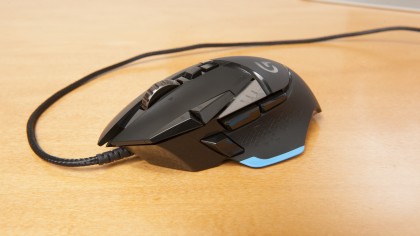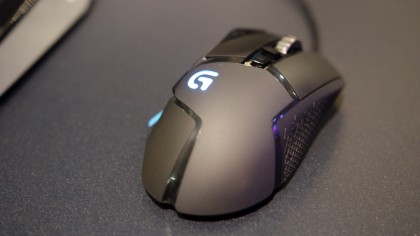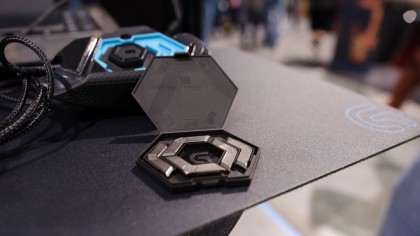TechRadar Verdict
For $79.99 (£69.99) the price is right for this overhauled gaming mouse and is recommended for the stubborn gamer that knows exactly what they like.
Pros
- +
Weight customization and surface customization are cool/practical features
- +
Responsive, versatile mouse suitable for myriad uses
- +
Great for claw-grip style of gaming
Cons
- -
Is 12,000 dpi really necessary?
- -
Left-click is a bit too close to the dpi shift keys
- -
Thumb rest doesn't jive well for palm-grip users
Why you can trust TechRadar
In case you didn't learn it in grade school Geology, it bears repeating: The earth has a liquid metal core. Looking for another fun fact? Logitech's wired G502 Proteus Core mouse has a solid metal core - up to five to be exact. As the replacement to the G500s as Logitech's flagship wired mouse, the Proteus Core has quite a legacy to live up to. Sporting a handful of great new features, it most certainly does.
The first and by far the biggest of which is an almost ludicrous dpi range. DPI, for those who don't keep track of all these crazy buzzwords that pop up all over the industry, means dots per inch. It's a measure of how sensitive a mouse's sensor is.

Setting a mouse at, say, 12,000 dpi (the Proteus Core's highest setting) means you don't have to move the mouse far for your cursor to travel further across the screen – or screens if you have a multi-monitor setup. It's powered by a 32-bit on-board microcontroller and can be changed by pressing the nifty dpi up, down, and shift buttons that raise and lower the sensitivity on the fly.
But the disgustingly high dpi begs the question, "why do we need something that sensitive?" The answer is we really don't. At a certain point, the high dpi becomes unwieldy.
At the mouse's maximum setting I was forced to turn down the sensitivity in the system settings to compensate, returning the mouse to reasonable tracking speed. This is an excessive, likely non-essential feature to the average gamer.
Gaming software
While a staggering dpi is by far the biggest change in Logitech's flagship wired mouse, it's not the only one. Another challenge mice of all breeds face are texture changes. For instance, if a mouse is calibrated for a hardwood surface (or soft mouse pad, realistically) and is then brought somewhere, say to a friend's house, and used on a different surface, its ability to be tracked is greatly impaired.
The fix? Logitech suggests the Logitech Gaming Software. In it you'll find a way to use your mouse to scan a surface and calibrate it to work just as well as if it were on a mouse pad. It's cool technology, and in practice works fairly well.

Testing on the Logitech G440 hard surface pad, the mouse feels responsive and precise. This is perhaps unsurprising considering its 1,000hz refresh rate. The real test came when, after taking for a test run on a Roccat Sense mouse pad and running the scanning software, it worked just as well before.
The surface calibration combined with the aforementioned addable weights - stored in the underside of the mouse and come in 3.6g increments, giving it a maximum weight of 138 grams - make for a very customizable experience. And that's before we talk about the G502's 11 macro buttons…

Macro buttons
Using the Logitech software with the G502 you're given two options for macro preferences: either set them on a per-game basis or make a custom setup in one of three on-board profiles.
While setting it on the former, I found commonly used commands for games like Counter Strike, Guild Wars II, and Skyrim, and though the software doesn't map anything for you, the setup process only takes a few minutes. Next, start up the .exe and the associated macro profile will go into effect.
Setting a custom macro profile may take a bit more time to get going, but is the preferable option if you're going to play the same three games every night.
That, however, is all the good news.
Design
Where the G502 falters is by radically shifting the aesthetic of the rounded, comfort-fitting G500s to a more angular, cramped design. It's gorgeous to look at, but not as nice to use.
A rubberized thumb rest on its left side should've offered comfortable respite. Instead, you'll have to uncomfortably wrap your hand in a claw-like fashion around the mouse putting pressure in the base of the wrist.
Where the design becomes problematic is with the close proximity of the left-mouse and dpi up/down buttons. Accidentally click the latter while you're in a life-or-death situation in Battlefield and I can assure you "life" won't really be an option.
The rest of the mouse's features will offset the dissatisfaction you feel when these accidents occur, but they are frequent minor inconveniences.
Lastly, the dual mode scroll-wheel offers "click-to-click" and smooth scrolling options, changed using a mechanical micro switch located just south of the scroll wheel.
While smooth scrolling may be the preferred choice while browsing the web, the click-to-click option gives gamers switching weapons in games like Team Fortress 2 an audible and tactile confirmation that their action was registered.
Verdict
The Logitech G502 Proteus Core is a solid gaming mouse that has some added quirks like a maximum dpi of 12,000, custom surface mapping, and five removable 3.6g weights that may - or may not - be of interest to you. Regardless, it's versatile enough to be used in Battlefield 4 one minute and browsing the web the next. For $79.99 (£69.99) the price is right for this overhauled gaming mouse and is recommended for the stubborn gamer that knows exactly what they like.
Nick Pino is Managing Editor, TV and AV for TechRadar's sister site, Tom's Guide. Previously, he was the Senior Editor of Home Entertainment at TechRadar, covering TVs, headphones, speakers, video games, VR and streaming devices. He's also written for GamesRadar+, Official Xbox Magazine, PC Gamer and other outlets over the last decade, and he has a degree in computer science he's not using if anyone wants it.

